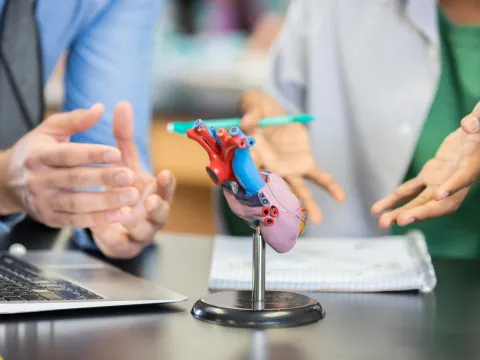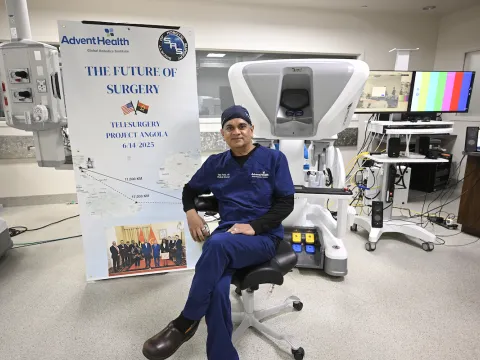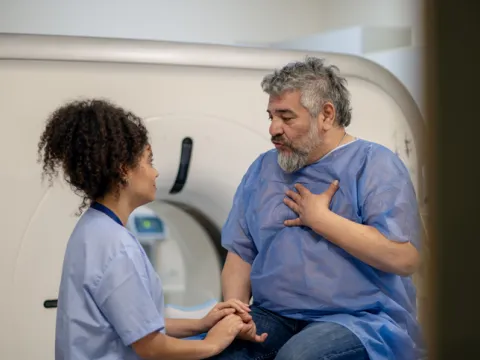- AdventHealth

Chief of Pediatric Head & Neck Surgery
AdventHealth for Children
This Clinician's View is written by Joseph Lopez, MD, MBA, Chief of Pediatric Head & Neck Surgery at AdventHealth for Children.
While relatively rare, head and neck tumors can occur in children, resulting in the need for surgical resection. Performing procedures in this region of an adult body, with all of its nerves and arteries, is complex. In children, the challenges are even greater as these critical structures are smaller and more compact.
We established the Pediatric Head and Neck Program at AdventHealth for Children in 2022 because we know our youngest patients require specialized surgical approaches to not only optimize their survival but also reduce morbidity from treatment. This includes preserving function and maximizing their quality of life for years to come. That is also why we have become among the first children’s hospitals in the country to begin using innovative technologies like near-infrared autofluorescence (NIRAF), intraoperative neuromonitoring, and intraoperative navigation for pediatric surgical cases.
Autofluorescence Technology — Protecting the Parathyroid During Pediatric Thyroid Surgery
Because the parathyroid is so small and lies directly on the surface of the thyroid, it can be difficult to fully differentiate during surgery, placing it at risk. In fact, the rate of transient or permanent hypoparathyroidism after total thyroidectomy in children is high with estimates ranging from 30-40%. When permanent, the resulting hypocalcemia (low blood calcium levels) can be especially burdensome for children, requiring them to maintain calcium supplementation 2-3 times a day for the rest of their lives.
Used in the adult population over the last 5-10 years, near-infrared autofluorescence (NIRAF) technology has emerged as a game-changer in thyroid surgery. It is a technique that detects the unique natural fluorescence in the near-infrared spectrum emitted by the parathyroid tissue. By using a laser of light in the proper wavelength and a detector, the parathyroid tissue can be differentiated from thyroid tissue, helping the surgeon identify and preserve the parathyroid glands. This helps to minimize complications like hypocalcemia and hypoparathyroidism.
For pediatric patients, this technology presents an ideal application due to the comparatively longer-term morbidity associated with a surgical complication like iatrogenic hypoparathyroidism. About 2 years ago, I began using NIRAF technologies for all our pediatric patients requiring thyroidectomy, including patients with autoimmune thyroid disease and thyroid cancer. So far, this has allowed us to achieve a permanent hypoparathyroidism rate of 4% for pediatric thyroid surgery, well below national and international averages.
Using Intraoperative Neuromonitoring and Navigation Technology to Improve Surgical Margins
When performing surgical resections for pediatric head and neck cancer cases, we know better margins equal better survival. However, it is also a bit of a balancing act as we aim to preserve as much structure and function as possible to optimize not only the quantity of our patient’s life, but their quality of life as well. That is why we recently began pioneering the application of two technologies used in the adult surgical world — intraoperative neuromonitoring and intraoperative navigation — to enhance the outcomes we can achieve with our pediatric surgical patients.
During head and neck surgery, intraoperative neuromonitoring provides us with continuous, real-time monitoring of nerve function to help identify and prevent nerve damage, particularly during procedures like thyroidectomy and parathyroidectomy.
At AdventHealth for Children, we are using this technology specifically to protect our patients from the risk of iatrogenic recurrent nerve injury. This nerve controls the voice and if damaged, can be a devastating injury, leading to vocal cord paralysis and symptoms like hoarseness and difficulty breathing. The intraoperative neuromonitoring technology uses a closed loop circuit to guarantee the neuromuscular integrity throughout the course of the surgery.
As for intraoperative navigation, this technology has been utilized since the 1980’s by the neurosurgical and otolaryngology fields for both cancer and non-cancer surgeries to precisely locate the region of interest and inform a minimally invasive surgical approach. Here’s how it works:
- Preoperatively, CT or MRI scans are used to create a 3D model of the patient’s anatomy.
- This data is then superimposed on the patient’s head and neck region during surgery.
- The navigation system uses a stereoscopic camera and infrared light to track the position of the surgical instruments throughout the procedure.
- The system displays the location of the instruments and the patient's anatomy on a monitor, allowing the surgeon to visualize the surgical area in real-time and accurately navigate.
At AdventHealth for Children, we recently became one of the first in the U.S. to use intraoperative navigation for pediatric head and neck cancer cases and believe it will improve the attainment of pathologically negative surgical margins in a complex surgical field, as it has in its adult counterparts. This innovative technology allows me as the surgeon to determine depth in 3D as I am navigating cavernous cavities that have a lot of real estate in terms of critical structures.
Because of its capabilities, I also find the intraoperative navigation technology useful when performing minimally invasive surgical procedures on babies with craniosynostosis as it enables me to visualize and confirm the correct structure. I find that computer-assisted surgical planning to customize bone-based tumor surgeries further enhances surgical planning and precision.
An Ongoing Commitment to Advancing Innovation That Improves Care for Children
As an early adopter of these technologies in the pediatric world, we plan to publish our experience and outcomes soon. Additionally, as the sub-specialty of pediatric head and neck surgery continues to grow and gain traction, our team hopes to collaborate on research projects with our peers in other centers in the U.S. and globally to grow our collective body of knowledge. We remain committed to pioneering and refining treatments, techniques and technologies that will positively impact the lives of our young patients, helping them to feel whole.
At AdventHealth for Children, our pediatric head and neck surgery program is already attracting patients from around the country, and we welcome referrals and the opportunity to provide second opinions or consult on complex cases.
Learn more about the AdventHelath for Children's Pediatric Head & Neck program here.





